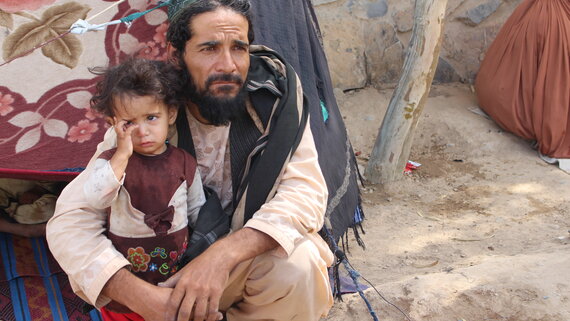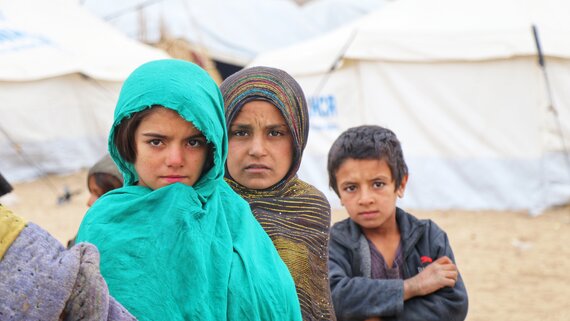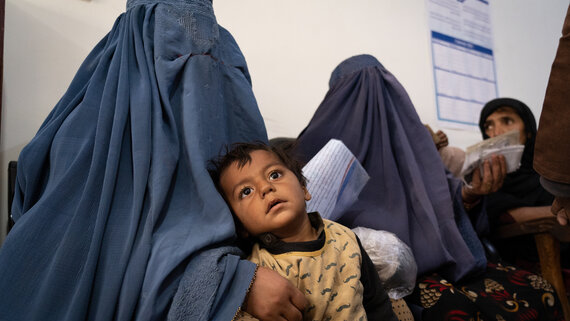Analysis of the context, crisis and needs
The combination of conflict, drought, COVID-19, political turmoil and recurrent economic shocks had a devastating impact on the people of Afghanistan. Ruptures in basic services, financial systems and civil service are exacerbating an already dire humanitarian situation.
A staggering 22.8 million people, or 55 per cent of the population, are expected to be in crisis or emergency levels of food insecurity (IPC 3+), a nearly 35 per cent increase from the same period last year. Some 9 million people are projected to be in IPC 4 – the highest number in the world. More than half of all children under 5 years of age are now expected to be acutely malnourished in 2022, a 21 per cent increase since the start of 2021. Twenty-seven out of 34 provinces are seeing acute malnutrition rising above emergency thresholds.
In rural areas, needs are largely driven by drought – the worst of its kind in 27 years – and the cumulative effects of over four decades of conflict. Even after the harvest, 57 per cent of households did not have food reserves that would last for three months. In urban areas, severe economic shocks and resulting income loss have contributed to the rapid deterioration in people’s food security and livelihoods status. Ten out of 11 most densely populated urban areas are anticipated to be in IPC 4. In 2021, all population groups had a negative net income.

Kandahar, Afghanistan
This unemployed father and his daughter were displaced to Kandahar from their hometown due to conflict and war. They now reside in Haji camp, where they do not have a decent home. In recent months the conflict has intensified and spread. The operating space for humanitarians providing life-saving assistance continues to shrink dramatically.
UNICEF/Naqeeb IsahaqDespite the prevalence of more deadly variants of COVID-19 and outbreaks of cholera, 66 per cent of the population reported not having enough water for handwashing. Conflict and COVID-19 have also interrupted schooling for more than 9.3 million children since 2020. Threats to civilians and acute protection needs remain high, and there are grave concerns about the rollback on women’s rights and restrictions on their participation in life and society. Densely populated areas are also contaminated with explosives, putting more people, particularly those trying to return, at risk of death and maiming. Afghanistan already has one of the world’s highest per capita populations of people with disabilities, with 79 per cent of adults and 17 per cent of children believed to live with some form of disability.
Projected situation in 2022 and beyond
An estimated 24.4 million people – 59 per cent of the population – will need humanitarian and protection assistance in 2022. This is largely driven by spiraling food insecurity, dangerous levels of malnutrition, eroded livelihood opportunities, as well as conflict-driven displacement and complex protection needs. Results from the 2022 Joint Inter-Sectoral Analysis Framework indicate that all 34 provinces are in severe or critical need, with 82 per cent of all provinces considered to have critical multisectoral needs. Similarly, all provinces across the country are projected to be in IPC 3 or 4.
Simultaneously, the political transition has disrupted basic services and critical development programmes – all on the backdrop of a crippling economic shock that has led to significant drops in income and evaporation of reserves across all income quintiles. Surging prices for food and other core commodities and severed remittances are drastically reducing people’s purchasing power.
Afghanistan HRP
The outlook for 2022 and beyond remains grim. People’s limited reserves have been expended, and many have already exhausted basic and even harmful and irreversible coping mechanisms to survive. Some 16.2 million people require protection assistance. Without continuity or appropriate alternative systems to maintain basic service provision, life-saving services are at risk of collapse. If all services cease, humanitarians expect a staggering 10 maternal, 55 neonatal and 112 child deaths each day. Forecasts indicate a potential second La Niña season ahead, causing a consecutive drought year and delivering a devastating blow to the population.
Response priorities in 2022
In 2022, humanitarian partners plan to reach 22.1 million people (91 per cent of PIN), requiring US$4.44 billion. The increase in planned reach is mostly driven by the sharp increase in the number of people in acute food insecurity. Active conflict, access challenges (particularly for female humanitarian staff), and banking and liquidity constraints have periodically impeded partners’ operations, but humanitarians have maintained their presence and delivered assistance in 387 of 401 districts in the third quarter (July – Sept) of 2021. By year’s end, partners plan to reach 17.5 million people (111 per cent of the initial 2021 HRP target).

Dand, Afghanistan
The 6,000 IDPs in Dand are some of the tens of thousands of people displaced from southern Afghanistan, forced to flee conflict in October last year. Many were farmers who were able to support themselves and their families before. But when they fled, they left behind their homes, land and livestock. Now they are internally displaced and living in tents with no access to their livelihoods.
OCHA/Fariba HousainiLimited humanitarian funding in previous years had driven a prioritization of low-cost and higher reach activities. People were reached with some form of assistance, but overall vulnerabilities did not improve. As a result, several sectors have revised their assistance modalities to increase volume and duration or include more comprehensive packages that more appropriately match the depth of people’s vulnerabilities and are more cost-effective in the long term. The response will also continue to emphasize the need to expand work on accountability to affected populations, reinforce the importance of protection from sexual exploitation and abuse, and strengthen gender, mental health and disability inclusion.
Achievements and innovations
Since 2020, the humanitarian community has made considerable progress in enhancing vulnerability-focused response, and it has improved analysis of chronic needs requiring social assistance to avert slippage into life-threatening categories. This year, humanitarians made an honest evaluation of the impact of past assistance on people’s living conditions. This showed that while assistance had offered an immediate lifeline, it was not sufficient to cover people’s basic needs.

Jalalabad, Afghanistan
A child and his mother wait at a cash distribution organized by an NGO in Jalalabad Province.
OCHA/Charlotte CansAs a result, humanitarians have revised the volume, duration and quality of core assistance packages commensurate to deepened vulnerabilities. The response will also modestly increase the range of costlier packages – such as shelter and water system repairs – which remain life-saving, offer medium-term relief and are cost-effective in the long run, by reducing future needs.
Further reading
Source: OCHA
Source: Humanitarian Insight
Source: Financial Tracking Service
References
- 2022 requirements are provisional
- Reach Initiative (June 2020). Winterization Evaluation (an evaluation of the winter assistance in 2019-2020).



